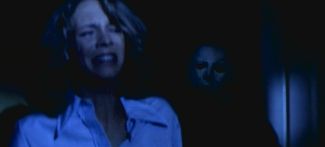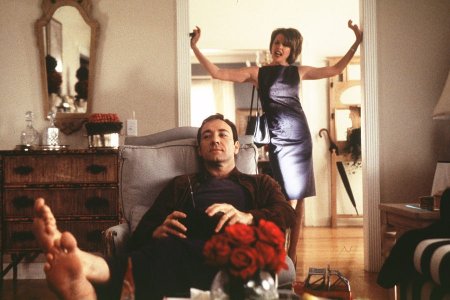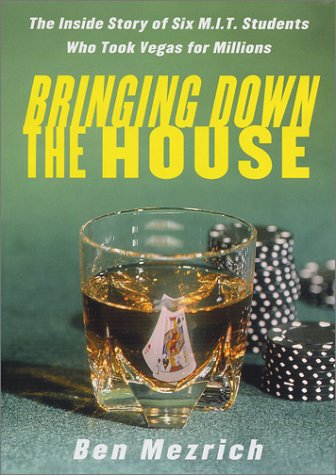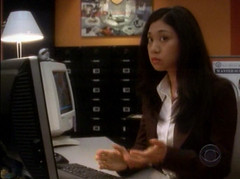
I recently read Carol J. Clover's Men, Women, and Chain Saws: Gender in the Modern Horror Film, an excellent critical analysis of slasher, possession and rape-revenge movies. Clover's book challenges the conventional wisdom that horror movies are inherently misogynistic, arguing instead that they instead do a great deal to challenge traditional gender roles - it's insightful and unpretentious, the rare tome that both Slavoj Zizek and Joe Bob Briggs could appreciate. In a neat coincidence, the same day I finished the book, I read Quentin Tarantino praising the book in Fangoria as hands-down the best of its kind.
Clover's book has a great deal to say about the Final Girl - the female character who confronts the monster and lives to fight another day. The Final Girl is often but not always chaste; she survives because she is resourceful, quick-witted and perceptive. Since Tarantino's Death Proof looks to be a tribute to the Final Girl, here are some of the best examples of the archetype:

1. T. Ellen Ripley (Sigourney Weaver), Alien While most horror films telegraph their survivors early on, Ripley emerges as the Final Girl gradually - she's stoic and remote, and not as immediately likeable as fellow crew member Lambert (Veronica Cartwright). But as her shipmates are picked off one by one, Ripley remains strong and decisive when Lambert can only sob helplessly. The final twenty minutes of Alien contain almost no dialogue, but our fear is sustained largely by Weaver's sweaty, wide-eyed, unforgettable performance as she outwits the tituar xenomorph before literally blowing it away. Ripley would live to fight, die, be reborn and fight again in the subsequent films, emerging as one of the greatest characters not only in horror but in all cinema.

2. Laurie Strode (Jamie Lee Curtis), Halloween A self-described Girl Scout who spends Halloween babysitting while her friends are busy drinking and screwing, Laurie is perhaps the beginning of the "good girls don't die" cliché. But, as Carpenter himself has pointed out, Laurie survives not because she's chaste but because she's full of repressed sexual energy, which ties her to Michael Myers and makes her a formidable foe. Whatever the Lacanian reading may be, she's deadly with a wire hanger. Curtis, of course, reprised the Final Girl role to great effect in several films, including The Fog, Road Games and Halloween II.

3. Suzy Bannion (Jessica Harper), Suspiria Suzy is the archetypal fairy-tale heroine, an innocent lost in the haunted woods (Germany's Black Forest) and trapped at a dance school run by witches (what an awesome premise!) who have mysterious but no doubt horrible plans for her. Harper is one of the great underusedd actresses of the 70's, and the sight of her delicate, almost alabaster features shrinking at the unknown horrors surrounding her enhances our own terrifying feeling of vulnerability. The final shots of Suzy's smiling escape are wonderfully triumphant, her relief mirroring ours.

4. Fran (Gaylen Ross), Dawn of the Dead As if trying to survive the start of a worldwide zombie epidemic weren't enough, Fran is also in the early stages of pregnancy. But rather than allowing her boyfriend and their virile companions to rescue her, Fran insists on learning to fly their helicopter, fire a gun and take care of herself. When her self-reliance pays off at the film's end, it's impossible not to applaud her.

5. Sally Hardesty (Marilyn Burns), The Texas Chain Saw Massacre Sally survives through pure endurance - for nearly half the film, she does not stop running as she flees Leatherface and his demented family. Managing to escape a particularly unpleasant dinner party, Sally escapes, though sadly, she's gone completely bananas. Burns' hysterical laughter at the film's end is one of the most unsettling (and imitated) moments in horror cinema.

6. Sue Snell (Amy Irving), Carrie Sue is unique in that her survival is particuarly grim - her well-intentioned attempt to do a good deed for poor Carrie White leaves her the only surviving member of her class. Like Sally, Sue isn't in great shape at the end, and Irving's screams punctuate cinema's definitive "Boo!" scare.

7. Nancy Thompson (Heather Langenkamp), A Nightmare on Elm Street A uniquely 80's heroine, Nancy reacts to the threat of a spectral child molester who threatens to kill her in her dreams by studying booby traps and makeshift weapons - many Final Girls have confronted their monsters, but few have whacked them in the groin with a sledgehammer. It is Nancy's ability to turn her back on Freddy that ultimately defeats him, though not for good - Langenkamp would return to give oddly stitled performances in two sequels.

8. Betty (Cristina Marsillach), Opera The young diva that finds herself caught in an endless, gooey mindfuck in Argento's best giallo is memorable for her kinks. Just minutes after witnessing her boyfriend's brutal murder, she's calmly chatting about her sexual hangups; as the film proceeds, we learn more about Betty's strange family history and how it connects her with the killer. Argento literalizes the repression theme that Carpenter implied in Halloween, and the result is a marvelously twisted slasher with a Final Girl who proclaims her love of all things warm in fuzzy in a final scene that would make David Lynch proud.

9. Alice Hardy (Adrienne King), Friday the 13th The virginal (though not drug-free) Alice isn't the most distinctive of characters, but she deserves inclusion here for three reasons. First, she kills Mrs. Voorhees and is therefore responsible for motivating her mentally challenged son - thought to be dead but apparently just wandering around the woods of Crystal Lake for two decades for no particular reason - to slaughter ten films' worth of horny teens in revenge. The second reason is her involvement in the first film's goofily perfect final scare, but less celebrated is her subsequent demise at the start of Friday the 13th Part 2, which began a tradition of slasher films' cheerfully cynical disregard for their protagonists.

10. Stretch (Caroline Williams), The Texas Chainsaw Massacre 2 The Texas DJ who runs afoul of Leatherface and his kin is referenced a great deal in Clover's book, and for good reason. While Hooper's spoofy take on his own masterpiece is uneven (and that's putting it very generously), I have an enormous amount of affection for it, largely due to the scene where Stretch neutralizes Leatherface by almost literally making love with his saw (the scene plays like the revenge of Cixous). Williams also gleefully recreates the final shot of the the first film with her own chainsaw dance - it's not the subtlest filmic representation of contemporary gender theory, but it is the grooviest.
Sidenote: while researching this Top 10, I stumbled across this completely awesome blog. I highly recommend that you check it out.
Clover's book has a great deal to say about the Final Girl - the female character who confronts the monster and lives to fight another day. The Final Girl is often but not always chaste; she survives because she is resourceful, quick-witted and perceptive. Since Tarantino's Death Proof looks to be a tribute to the Final Girl, here are some of the best examples of the archetype:

1. T. Ellen Ripley (Sigourney Weaver), Alien While most horror films telegraph their survivors early on, Ripley emerges as the Final Girl gradually - she's stoic and remote, and not as immediately likeable as fellow crew member Lambert (Veronica Cartwright). But as her shipmates are picked off one by one, Ripley remains strong and decisive when Lambert can only sob helplessly. The final twenty minutes of Alien contain almost no dialogue, but our fear is sustained largely by Weaver's sweaty, wide-eyed, unforgettable performance as she outwits the tituar xenomorph before literally blowing it away. Ripley would live to fight, die, be reborn and fight again in the subsequent films, emerging as one of the greatest characters not only in horror but in all cinema.

2. Laurie Strode (Jamie Lee Curtis), Halloween A self-described Girl Scout who spends Halloween babysitting while her friends are busy drinking and screwing, Laurie is perhaps the beginning of the "good girls don't die" cliché. But, as Carpenter himself has pointed out, Laurie survives not because she's chaste but because she's full of repressed sexual energy, which ties her to Michael Myers and makes her a formidable foe. Whatever the Lacanian reading may be, she's deadly with a wire hanger. Curtis, of course, reprised the Final Girl role to great effect in several films, including The Fog, Road Games and Halloween II.

3. Suzy Bannion (Jessica Harper), Suspiria Suzy is the archetypal fairy-tale heroine, an innocent lost in the haunted woods (Germany's Black Forest) and trapped at a dance school run by witches (what an awesome premise!) who have mysterious but no doubt horrible plans for her. Harper is one of the great underusedd actresses of the 70's, and the sight of her delicate, almost alabaster features shrinking at the unknown horrors surrounding her enhances our own terrifying feeling of vulnerability. The final shots of Suzy's smiling escape are wonderfully triumphant, her relief mirroring ours.

4. Fran (Gaylen Ross), Dawn of the Dead As if trying to survive the start of a worldwide zombie epidemic weren't enough, Fran is also in the early stages of pregnancy. But rather than allowing her boyfriend and their virile companions to rescue her, Fran insists on learning to fly their helicopter, fire a gun and take care of herself. When her self-reliance pays off at the film's end, it's impossible not to applaud her.

5. Sally Hardesty (Marilyn Burns), The Texas Chain Saw Massacre Sally survives through pure endurance - for nearly half the film, she does not stop running as she flees Leatherface and his demented family. Managing to escape a particularly unpleasant dinner party, Sally escapes, though sadly, she's gone completely bananas. Burns' hysterical laughter at the film's end is one of the most unsettling (and imitated) moments in horror cinema.

6. Sue Snell (Amy Irving), Carrie Sue is unique in that her survival is particuarly grim - her well-intentioned attempt to do a good deed for poor Carrie White leaves her the only surviving member of her class. Like Sally, Sue isn't in great shape at the end, and Irving's screams punctuate cinema's definitive "Boo!" scare.

7. Nancy Thompson (Heather Langenkamp), A Nightmare on Elm Street A uniquely 80's heroine, Nancy reacts to the threat of a spectral child molester who threatens to kill her in her dreams by studying booby traps and makeshift weapons - many Final Girls have confronted their monsters, but few have whacked them in the groin with a sledgehammer. It is Nancy's ability to turn her back on Freddy that ultimately defeats him, though not for good - Langenkamp would return to give oddly stitled performances in two sequels.

8. Betty (Cristina Marsillach), Opera The young diva that finds herself caught in an endless, gooey mindfuck in Argento's best giallo is memorable for her kinks. Just minutes after witnessing her boyfriend's brutal murder, she's calmly chatting about her sexual hangups; as the film proceeds, we learn more about Betty's strange family history and how it connects her with the killer. Argento literalizes the repression theme that Carpenter implied in Halloween, and the result is a marvelously twisted slasher with a Final Girl who proclaims her love of all things warm in fuzzy in a final scene that would make David Lynch proud.

9. Alice Hardy (Adrienne King), Friday the 13th The virginal (though not drug-free) Alice isn't the most distinctive of characters, but she deserves inclusion here for three reasons. First, she kills Mrs. Voorhees and is therefore responsible for motivating her mentally challenged son - thought to be dead but apparently just wandering around the woods of Crystal Lake for two decades for no particular reason - to slaughter ten films' worth of horny teens in revenge. The second reason is her involvement in the first film's goofily perfect final scare, but less celebrated is her subsequent demise at the start of Friday the 13th Part 2, which began a tradition of slasher films' cheerfully cynical disregard for their protagonists.

10. Stretch (Caroline Williams), The Texas Chainsaw Massacre 2 The Texas DJ who runs afoul of Leatherface and his kin is referenced a great deal in Clover's book, and for good reason. While Hooper's spoofy take on his own masterpiece is uneven (and that's putting it very generously), I have an enormous amount of affection for it, largely due to the scene where Stretch neutralizes Leatherface by almost literally making love with his saw (the scene plays like the revenge of Cixous). Williams also gleefully recreates the final shot of the the first film with her own chainsaw dance - it's not the subtlest filmic representation of contemporary gender theory, but it is the grooviest.
Sidenote: while researching this Top 10, I stumbled across this completely awesome blog. I highly recommend that you check it out.








